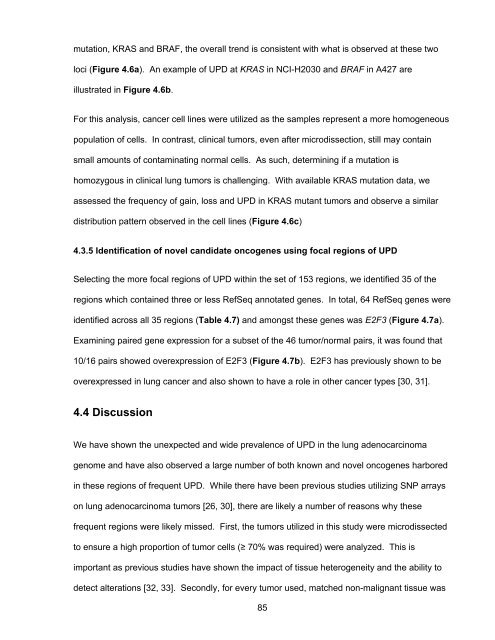Chapter 2 - University of British Columbia
Chapter 2 - University of British Columbia
Chapter 2 - University of British Columbia
You also want an ePaper? Increase the reach of your titles
YUMPU automatically turns print PDFs into web optimized ePapers that Google loves.
mutation, KRAS and BRAF, the overall trend is consistent with what is observed at these two<br />
loci (Figure 4.6a). An example <strong>of</strong> UPD at KRAS in NCI-H2030 and BRAF in A427 are<br />
illustrated in Figure 4.6b.<br />
For this analysis, cancer cell lines were utilized as the samples represent a more homogeneous<br />
population <strong>of</strong> cells. In contrast, clinical tumors, even after microdissection, still may contain<br />
small amounts <strong>of</strong> contaminating normal cells. As such, determining if a mutation is<br />
homozygous in clinical lung tumors is challenging. With available KRAS mutation data, we<br />
assessed the frequency <strong>of</strong> gain, loss and UPD in KRAS mutant tumors and observe a similar<br />
distribution pattern observed in the cell lines (Figure 4.6c)<br />
4.3.5 Identification <strong>of</strong> novel candidate oncogenes using focal regions <strong>of</strong> UPD<br />
Selecting the more focal regions <strong>of</strong> UPD within the set <strong>of</strong> 153 regions, we identified 35 <strong>of</strong> the<br />
regions which contained three or less RefSeq annotated genes. In total, 64 RefSeq genes were<br />
identified across all 35 regions (Table 4.7) and amongst these genes was E2F3 (Figure 4.7a).<br />
Examining paired gene expression for a subset <strong>of</strong> the 46 tumor/normal pairs, it was found that<br />
10/16 pairs showed overexpression <strong>of</strong> E2F3 (Figure 4.7b). E2F3 has previously shown to be<br />
overexpressed in lung cancer and also shown to have a role in other cancer types [30, 31].<br />
4.4 Discussion<br />
We have shown the unexpected and wide prevalence <strong>of</strong> UPD in the lung adenocarcinoma<br />
genome and have also observed a large number <strong>of</strong> both known and novel oncogenes harbored<br />
in these regions <strong>of</strong> frequent UPD. While there have been previous studies utilizing SNP arrays<br />
on lung adenocarcinoma tumors [26, 30], there are likely a number <strong>of</strong> reasons why these<br />
frequent regions were likely missed. First, the tumors utilized in this study were microdissected<br />
to ensure a high proportion <strong>of</strong> tumor cells (≥ 70% was required) were analyzed. This is<br />
important as previous studies have shown the impact <strong>of</strong> tissue heterogeneity and the ability to<br />
detect alterations [32, 33]. Secondly, for every tumor used, matched non-malignant tissue was<br />
85

















